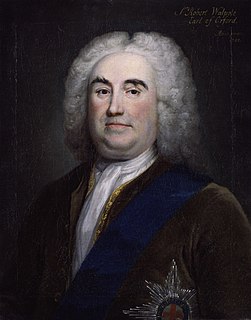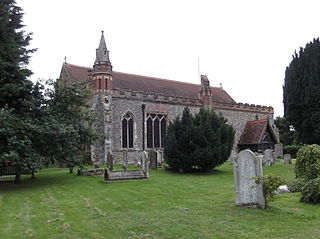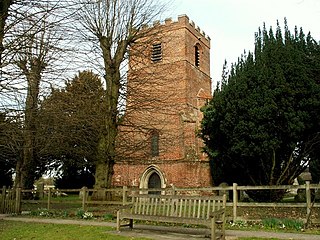
Robert Walpole, 1st Earl of Orford,, known between 1725 and 1742 as Sir Robert Walpole, was a British statesman who is generally regarded as the de facto first Prime Minister of Great Britain.

Baron Bethell, of Romford in the County of Essex, is a title in the Peerage of the United Kingdom. It was created in the 1922 Dissolution Honours for the banker and Liberal politician Sir John Bethell, 1st Baronet, who had previously represented Romford and East Ham North in Parliament. He had already been created a Baronet, of Romford in the County of Essex, on 26 June 1911.

Hursley is a village and civil parish in Hampshire, England with a population of around 800 in 2005. It is located roughly midway between Romsey and Winchester on the A3090. Besides the village the parish includes the hamlets of Standon and Pitt and the outlying settlement at Farley Chamberlayne.

Compton Chamberlayne is a small village and civil parish in south Wiltshire, England, situated in the Nadder Valley approximately 7 miles (11 km) west of Salisbury. The River Nadder forms the northern border of the parish, and to the south are chalk hills. The parish is bisected by the A30 road. The village contains approximately 25 privately owned houses, a village hall, and a cricket pitch used by the Compton Chamberlayne Cricket Club.
William Yates was a British Conservative politician and later an Australian Liberal politician. He was one of several to have served in both the UK and Australian parliaments.

Colin Christopher Paget Tennant, 3rd Baron Glenconner was a British aristocrat. He was the son of Christopher Grey Tennant, 2nd Baron Glenconner, and Pamela Winefred Paget. He was also the nephew of Edward Wyndham Tennant and Stephen Tennant, and the brother of the novelist Emma Tennant.
John Burke was an Irish genealogist, and the original publisher of Burke's Peerage. He was the father of Sir Bernard Burke, a British officer of arms and genealogist.

Sir William Craven was an English merchant, Lord Mayor of London in 1610. It has been noted that the story of Dick Whittington has some similarities to Craven's career, though the story was first published before Craven became Lord Mayor.

Sir Walter Devereux, 5th Viscount Hereford, 2nd Baronet of Castle Bromwich, was an English politician who sat in the House of Commons at various times, between 1614 and 1624, before succeeding to the family Viscountcy in the peerage of England.
Richard Wenman, 1st Viscount Wenman (1573–1640) was an English soldier and politician who sat in the House of Commons between 1621 and 1625. He was created Viscount Wenman in the Peerage of Ireland in 1628.

Cranbury Park is a stately home and country estate situated in the parish of Hursley, near to Otterbourne, Winchester, England. It was formerly the home to Sir Isaac Newton and later to the Chamberlayne family, whose descendants now own and occupy the house and surrounding park and farmland. The house and park are not generally open to the public, although open days are occasionally held.

51.768942°N 0.602896°E

Braxted Park, formerly called Braxted Lodge, is a country house in the Queen Anne style set in a landscaped 2,000 acre park near the village of Great Braxted, Essex. In the Domesday Book of 1086, Eudo Dapifer is shown as owner of the manor. All Saints' Church, originally built in about 1115 and restored in the 18th century, also lies within the park grounds.
Vere Essex Cromwell, 4th Earl of Ardglass PC (I), was an English nobleman, son of Thomas Cromwell, 1st Earl of Ardglass and Elizabeth Meverell.

St James House is a grade II listed building in Monmouth, Monmouthshire, Wales. It is in the historic St James Square neighbourhood, within the Medieval town walls. While the house currently has an attractive, 18th-century facade, it originated as a burgage tenement. In addition, behind the house, evidence of a kiln has been unearthed, with both Medieval and Post-medieval pottery. In 2010, archaeological excavation in the square revealed the first evidence of Mesolithic human settlement in Monmouth. Recent residents of St James House have included boarding students from Monmouth School.
John Leventhorpe, of Sawbridgeworth, Hertfordshire and Ugley, Essex, was an English politician and one of the executors of both Henry IV's and Henry V's wills.
Eleonora Elisa Fiaschi Tennant was an Australian political activist, best known for her campaigns in the United Kingdom. A society figure, she was mainly associated with groups on the right-wing fringes of the Conservative Party.

Robert Tennant of Chapel House in the parish of Conistone, Yorkshire, England, was the Conservative Party Member of Parliament for Leeds, Yorkshire, from 1874 to 1880. He served as a Captain in the Yorkshire Hussars and as a Justice of the Peace for Yorkshire and for Ross and Cromarty and Sutherland in Scotland.

















